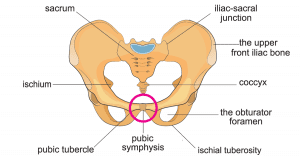What is my pubic bone exactly?
Your pubic bone, or pubic symphysis, is found on the front side of your pelvis where the two sides connect. They connect to form a cartilage joint: the symphysis pubis. This joint is responsible for keeping the two bones of the pelvis together and stable during physical activity. There are four ligaments that help connect the pubic bone, which function to decrease the stresses which the pubic bone is responsible for bearing.

How Common is it?
Some studies show prevalence of SPD as high as 75% during the first trimester, and 89% during the second and third trimesters.
Description of Symptoms:
Typically pubic pain (or Pubic Symphysis Dysfunction) presents as pain or discomfort in the region of the pelvis, which can radiate to the upper thighs and genital region.
Symptoms may include any of the following:
Pain; burning, shooting, or stabbing
Mild or prolonged
Typically can be relieved by resting
Difficulty with walking, going up or down stairs, getting up from a chair or turning in bed
Difficulty with hip movements
Possible “clicking” in the lower back, hip joints or sacroiliac joints with movement
Why do I have it?
The direct cause of pubic pain (SPD) is uncertain but it is believed to be related to the changes that occur during pregnancy. Pregnancy causes a change in the load borne by the pelvis, changes in ligamentous control/strength, and muscle changes as well. All of these changes can then in turn lead to instability in the spine and pelvis, which then may be experienced by the patient as “pubic pain”.
Other factors that may contribute to SPD may include the following:
Physically strenuous work during pregnancy
Fracture, or history of a fracture
Poor posture
Lack of exercise
Diastasis Recti
Increased weight gain
Misalignment of the pelvis
Number of pregnancies
Age of the mother
History of difficult deliveries
How Can Physical Therapy Help?
A trained physical therapist can screen you for SPD, and determine if that is the correct diagnosis for the pain/symptoms you’re experiencing. Once a correct diagnosis is determined there are many ways a PT can assist you with relieving your pain and discomfort.
Devices can be prescribed/suggested to assist with unweighting of the pubic structure and assisting in pain control. There are also birth planning positions you may want to consider, this is a discussion you can have with both the PT and your OBGYN/Midwife. There are also preventative measures we can help with, to assist with the emotional toll the pain and discomfort can cause for you during your pregnancy. Your PT can also prescribe certain exercises/stretches to perform and activities to avoid when experiencing SPD.
If your OBGYN and physical therapist have agreed that prenatal exercise is safe for you and you are looking for local prenatal yoga, massage or fitness classes, use the button below to download a list of recommended programs in the Syracuse area.

